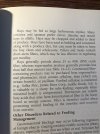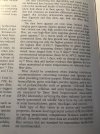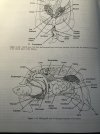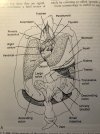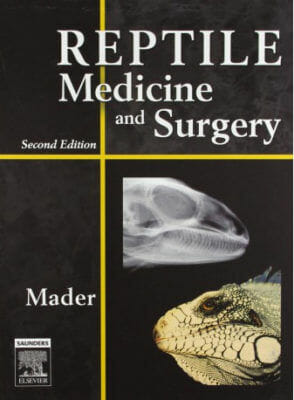To preface, I have no idea what I'm talking about, and this might be a very long and convoluted post. Please bear with me, I'll get to the point eventually. You could probably skip the first two paragraphs and the rest would still make sense. I've been writing this out over a long period of time and don't actually remember the exact point I was trying to make, so I might have lost the plot about half way through.
Last semester, I took Principals of Animal Nutrition as my one required animal science class for my degree. I actually have no idea how I registered for it because I don't even have the prerequisite classes, but I'm glad I was able to. The professor was wonderful, and I enjoyed the class immensely, so much so that I made the highest score on the final out of 250 people (that's neither here nor there, I'm just bragging). I found the material very, very interesting. However, I realize that this class probably barely scratched the surface on digestion and nutrition in animals, and in the grand scheme of things, I know nothing. That's where you guys hopefully come in.
The main focus of the class was on the difference between ruminants and non-ruminants (foregut/hindgut fermenters), more specifically the differences in digestion between pigs, horses, and cows. The baseline for much of what we learned was that structure, or anatomy, dictates function. Pigs have the longest small intestine comparatively of the three, and will get the most use out of nonstructural carbohydrates (Starch (Amylose/Amylopectin), lactose, sucrose, glucose/galactose/fructose, etc., will be referred to as NCHO), and will have very little gain from fermentation in the large intestine. Cows have the reticulum/rumen, and will ferment both structural carbohydrates (Cellulose, pectin... will be referred to as SCHO) that are undigestible in the small intestine, and nonstructural carbohydrates that would be easily digestible, into Volatile fatty acids (acetate, propionate, butyrate, will now be referred to as VFAs). This fermentation occurs through microbial enzymes, and structural carbohydrate can only be fermented and utilized via microbes in fermentation chambers, like the rumen and large intestine. Because feed passes through the reticulo-rumen before the small intestine, ruminants (cows) are also able to benefit from microbial crude protein (the raw microbes and enzymes used to ferment) and microbial phospholipids, which can then pass into the stomach and small intestine to be absorbed. Methane and carbon dioxide are waste byproducts of fermentation. Feeding more NCHO leads to an increased production of propionate, which is a hydrogen sink, and limits methane production. Propionate is also glucogenic, meaning that more glucose can be created from it and used as energy or stored as glycogen/fat, and is what creates marbling in beef.
Horses are special, in that I assume their digestive anatomy to be the most similar to grass eating species of tortoises. They have a very small stomach and small intestine comparatively, increasing rate of passage into the large intestine. Horses have a very large large intestine and cecum, and much of their feed will be fermented. This makes sense, because animals grazing on grass and fibrous weeds will not be able to digest the cellulose and other SCHO contained in the cell walls of the plants in their small intestine, and will rely entirely on fermentation to absorb nutrients via VFAs produced by microbes. Since they are not ruminants and do not have foregut fermentation that will allow the protein and lipids to pass through the stomach and small intestine, the microbial crude protein and microbial phospholipids produced as products of fermentation will be excreted as waste.
I went searching for dissections of tortoises, specifically sulcatas, to compare their anatomy. Unfortunately, I came up empty handed, and so did my professor when he searched for me (I suppose having a doctorate makes you good at using google scholar). If someone knows where I can find one without opening up my own tortoises, please let me know. My assumption, even though they're not mammals, is that they also have shorter small intestines and very sizable large intestines to better absorb nutrients from the fermentation of structural carbohydrates from fibrous plants. Nonstructural carbohydrates, like fructose, starch, and glucose, will come from fleshy vegetables and fruits, with fruits and sweet vegetables containing much more fructose. Fructose and glucose, as monosaccharides, are extremely easily digestible, as they do not have to be broken down by mammalian enzymes (Reptiles are not mammals but we will be referring to non-microbial, animal-made enzymes as mammalian for the purposes of this post) before they can be digested, whereas polysaccharides like starch and disaccharides like sucrose do. These will be digested in the small intestine, and anything undigested will be fermented in the large intestine.
Before I continue, I have to touch on acidosis. Ruminal acidosis is a malady in ruminants caused by the decrease in pH in the rumen, killing microbes. In cows, this decrease in pH occurs when the animal is fed large quantities of nonstructural carbohydrates, like starchy vegetables or sweet fruits, in a short period of time. Microbes that produce lactate, or lactic acid, like streptococcus Bovis, use the NCHO to grow, and produce the lactic acid as a biproduct. This acid lowers the pH of the rumen, and kills microbes that convert lactate to glucose, like megasphaera elsdenii. The pH continues to lower as more lactic acid accumulates, and becomes too acidic to support microbial life. This leads to a lack of fermentation in the rumen, and can easily be fatal to the animal. My professor shared an anecdote where a woman called him, frantic about her cows that were dropping dead out of nowhere. As it turns out, she returned from a potluck with a large quantity of mashed potatoes and decided to give the leftovers to her cows as a treat. The large amount of starch fed in one sitting lead to ruminal acidosis. Some did recover, but a good few of them died just from that feeding. (I don't actually know anything about cows and the prof didn't share too many more details, so I suppose it is possible there was more than just that one feeding.)
With these ideas in mind, I came to my professor's office hours with a few tortoise related questions. He, understandably, knew little to nothing about digestion in reptiles, so I framed them as questions about horses under the impression that their digestive anatomy is similar enough for my purposes.
My questions and his (paraphrased) answers were as follows:
1) Can something like ruminal acidosis happen in the large intestine if a horse is fed large quantities of fruit or other sources of NCHO?
-Yes, and it's a problem that people really try to avoid. It's called acidosis laminitis, or hindgut acidosis. I imagine that this is the problem that feeding too much fruit to a tortoise will cause.
2) Sometimes people say that tortoises use movement to digest, like horses. Is movement an important factor in horse digestion?
-Movement is in general helpful for digestion, and that is not limited to horses. He actually recommended that I track the effects of enclosure size on distance walked and digestion, since a larger enclosure may not necessarily increase distance walked if the tortoise walks for the same amount of time at the same speed regardless. I found this suggestion very interesting and I would like to look into it further if I ever have the time and resources.
During our discussion about the structure of a tortoise's digestive system, he made the point that much of their food will come out undigested, made clear by the sheer amount of poop a tortoise produces, they very fibrous appearance of it when fed a high fiber diet, especially in grass eating species, and the amount that they eat. Therefore, my understanding is that the goal of a tortoise is to eat as much as possible, to digest as much as they can, in the very limited amount of time they have to digest it before it leaves their large intestine.
With these points in mind, my questions for you all are as follows:
1. What is the anatomical difference between fruit eating species like redfoots, and something like a russian or sulcata? Do redfoots have a larger small intestine comparatively, allowing more time for sugary foods to be digested before reaching the large intestine, or is it a difference in the species of microbe in the large intestine, like maybe fewer lactate or other acid producers, or microbes that are more tolerant of a lower pH?
2. Is the manner in which their food is prepared just as important as the amount fed and the items offered? If someone were to blend their tortoise's food, or otherwise chop it into pieces smaller than the tortoise would otherwise bite off, this would undoubtable increase digestion by increasing the surface area for enzymes to act on. Ignoring the effect this may have on a tortoise's beak, could a fully grown tortoise being fed a high quality diet in a large enclosure be overfed by increasing digestion this way? I imagine it would just increase growth rate in hatchlings and growing tortoises with little to no ill-effects. Conversely, could a tortoise be underfed by feeding an unlimited amount of solely high fibered items, like grasses, that will not be digested fully before leaving the body, especially to species that are not strictly grass eaters?
3. Could an amount of fruit or otherwise easily digestible food item, fed gradually enough to be mostly digested before reaching the large intestine, be beneficial to species that do not eat fruit for it's ease of digestibility? I realize this may be a dumb hypothetical because that amount might be completely negligible and no one knows what that specific amount would be.
4. What, specifically, does hindgut acidosis caused by fruit do to a tortoise? Are they just unable to break down fibrous foods until their microbe population recovers? How long might that take? I realize that people probably don't have an exact answer to this because it hasn't been studied in tortoises, as far as I know.
5. Does anyone have access to tortoise dissection pictures or videos? I'd really like to learn more about their internal anatomy, and especially internal differences between species.
6. Are there any big, important differences in digestion between reptiles and mammals?
To be clear, I am not recommending that people go out and start trying to feed their tortoises fruit or chop up everything they feed into tiny pieces. Any problem or hypothetical I've brought up is fixable with a varied diet of mostly high fibered food items, like weeds and grasses, with easily digestible items, like grocery store veggies, cactus pads (I'm just assuming that they're easily digestible but I don't actually know), and fleshy vegetables in moderation, available to a tortoise at any time to graze on in a large enclosure. I just find this topic really interesting and would like to talk about it in more depth than just "don't feed fruit". I'm pretty sure I had more questions, but I can't remember what they were. I'm sure I'll remember eventually and add them as stand alone replies.
Last semester, I took Principals of Animal Nutrition as my one required animal science class for my degree. I actually have no idea how I registered for it because I don't even have the prerequisite classes, but I'm glad I was able to. The professor was wonderful, and I enjoyed the class immensely, so much so that I made the highest score on the final out of 250 people (that's neither here nor there, I'm just bragging). I found the material very, very interesting. However, I realize that this class probably barely scratched the surface on digestion and nutrition in animals, and in the grand scheme of things, I know nothing. That's where you guys hopefully come in.
The main focus of the class was on the difference between ruminants and non-ruminants (foregut/hindgut fermenters), more specifically the differences in digestion between pigs, horses, and cows. The baseline for much of what we learned was that structure, or anatomy, dictates function. Pigs have the longest small intestine comparatively of the three, and will get the most use out of nonstructural carbohydrates (Starch (Amylose/Amylopectin), lactose, sucrose, glucose/galactose/fructose, etc., will be referred to as NCHO), and will have very little gain from fermentation in the large intestine. Cows have the reticulum/rumen, and will ferment both structural carbohydrates (Cellulose, pectin... will be referred to as SCHO) that are undigestible in the small intestine, and nonstructural carbohydrates that would be easily digestible, into Volatile fatty acids (acetate, propionate, butyrate, will now be referred to as VFAs). This fermentation occurs through microbial enzymes, and structural carbohydrate can only be fermented and utilized via microbes in fermentation chambers, like the rumen and large intestine. Because feed passes through the reticulo-rumen before the small intestine, ruminants (cows) are also able to benefit from microbial crude protein (the raw microbes and enzymes used to ferment) and microbial phospholipids, which can then pass into the stomach and small intestine to be absorbed. Methane and carbon dioxide are waste byproducts of fermentation. Feeding more NCHO leads to an increased production of propionate, which is a hydrogen sink, and limits methane production. Propionate is also glucogenic, meaning that more glucose can be created from it and used as energy or stored as glycogen/fat, and is what creates marbling in beef.
Horses are special, in that I assume their digestive anatomy to be the most similar to grass eating species of tortoises. They have a very small stomach and small intestine comparatively, increasing rate of passage into the large intestine. Horses have a very large large intestine and cecum, and much of their feed will be fermented. This makes sense, because animals grazing on grass and fibrous weeds will not be able to digest the cellulose and other SCHO contained in the cell walls of the plants in their small intestine, and will rely entirely on fermentation to absorb nutrients via VFAs produced by microbes. Since they are not ruminants and do not have foregut fermentation that will allow the protein and lipids to pass through the stomach and small intestine, the microbial crude protein and microbial phospholipids produced as products of fermentation will be excreted as waste.
I went searching for dissections of tortoises, specifically sulcatas, to compare their anatomy. Unfortunately, I came up empty handed, and so did my professor when he searched for me (I suppose having a doctorate makes you good at using google scholar). If someone knows where I can find one without opening up my own tortoises, please let me know. My assumption, even though they're not mammals, is that they also have shorter small intestines and very sizable large intestines to better absorb nutrients from the fermentation of structural carbohydrates from fibrous plants. Nonstructural carbohydrates, like fructose, starch, and glucose, will come from fleshy vegetables and fruits, with fruits and sweet vegetables containing much more fructose. Fructose and glucose, as monosaccharides, are extremely easily digestible, as they do not have to be broken down by mammalian enzymes (Reptiles are not mammals but we will be referring to non-microbial, animal-made enzymes as mammalian for the purposes of this post) before they can be digested, whereas polysaccharides like starch and disaccharides like sucrose do. These will be digested in the small intestine, and anything undigested will be fermented in the large intestine.
Before I continue, I have to touch on acidosis. Ruminal acidosis is a malady in ruminants caused by the decrease in pH in the rumen, killing microbes. In cows, this decrease in pH occurs when the animal is fed large quantities of nonstructural carbohydrates, like starchy vegetables or sweet fruits, in a short period of time. Microbes that produce lactate, or lactic acid, like streptococcus Bovis, use the NCHO to grow, and produce the lactic acid as a biproduct. This acid lowers the pH of the rumen, and kills microbes that convert lactate to glucose, like megasphaera elsdenii. The pH continues to lower as more lactic acid accumulates, and becomes too acidic to support microbial life. This leads to a lack of fermentation in the rumen, and can easily be fatal to the animal. My professor shared an anecdote where a woman called him, frantic about her cows that were dropping dead out of nowhere. As it turns out, she returned from a potluck with a large quantity of mashed potatoes and decided to give the leftovers to her cows as a treat. The large amount of starch fed in one sitting lead to ruminal acidosis. Some did recover, but a good few of them died just from that feeding. (I don't actually know anything about cows and the prof didn't share too many more details, so I suppose it is possible there was more than just that one feeding.)
With these ideas in mind, I came to my professor's office hours with a few tortoise related questions. He, understandably, knew little to nothing about digestion in reptiles, so I framed them as questions about horses under the impression that their digestive anatomy is similar enough for my purposes.
My questions and his (paraphrased) answers were as follows:
1) Can something like ruminal acidosis happen in the large intestine if a horse is fed large quantities of fruit or other sources of NCHO?
-Yes, and it's a problem that people really try to avoid. It's called acidosis laminitis, or hindgut acidosis. I imagine that this is the problem that feeding too much fruit to a tortoise will cause.
2) Sometimes people say that tortoises use movement to digest, like horses. Is movement an important factor in horse digestion?
-Movement is in general helpful for digestion, and that is not limited to horses. He actually recommended that I track the effects of enclosure size on distance walked and digestion, since a larger enclosure may not necessarily increase distance walked if the tortoise walks for the same amount of time at the same speed regardless. I found this suggestion very interesting and I would like to look into it further if I ever have the time and resources.
During our discussion about the structure of a tortoise's digestive system, he made the point that much of their food will come out undigested, made clear by the sheer amount of poop a tortoise produces, they very fibrous appearance of it when fed a high fiber diet, especially in grass eating species, and the amount that they eat. Therefore, my understanding is that the goal of a tortoise is to eat as much as possible, to digest as much as they can, in the very limited amount of time they have to digest it before it leaves their large intestine.
With these points in mind, my questions for you all are as follows:
1. What is the anatomical difference between fruit eating species like redfoots, and something like a russian or sulcata? Do redfoots have a larger small intestine comparatively, allowing more time for sugary foods to be digested before reaching the large intestine, or is it a difference in the species of microbe in the large intestine, like maybe fewer lactate or other acid producers, or microbes that are more tolerant of a lower pH?
2. Is the manner in which their food is prepared just as important as the amount fed and the items offered? If someone were to blend their tortoise's food, or otherwise chop it into pieces smaller than the tortoise would otherwise bite off, this would undoubtable increase digestion by increasing the surface area for enzymes to act on. Ignoring the effect this may have on a tortoise's beak, could a fully grown tortoise being fed a high quality diet in a large enclosure be overfed by increasing digestion this way? I imagine it would just increase growth rate in hatchlings and growing tortoises with little to no ill-effects. Conversely, could a tortoise be underfed by feeding an unlimited amount of solely high fibered items, like grasses, that will not be digested fully before leaving the body, especially to species that are not strictly grass eaters?
3. Could an amount of fruit or otherwise easily digestible food item, fed gradually enough to be mostly digested before reaching the large intestine, be beneficial to species that do not eat fruit for it's ease of digestibility? I realize this may be a dumb hypothetical because that amount might be completely negligible and no one knows what that specific amount would be.
4. What, specifically, does hindgut acidosis caused by fruit do to a tortoise? Are they just unable to break down fibrous foods until their microbe population recovers? How long might that take? I realize that people probably don't have an exact answer to this because it hasn't been studied in tortoises, as far as I know.
5. Does anyone have access to tortoise dissection pictures or videos? I'd really like to learn more about their internal anatomy, and especially internal differences between species.
6. Are there any big, important differences in digestion between reptiles and mammals?
To be clear, I am not recommending that people go out and start trying to feed their tortoises fruit or chop up everything they feed into tiny pieces. Any problem or hypothetical I've brought up is fixable with a varied diet of mostly high fibered food items, like weeds and grasses, with easily digestible items, like grocery store veggies, cactus pads (I'm just assuming that they're easily digestible but I don't actually know), and fleshy vegetables in moderation, available to a tortoise at any time to graze on in a large enclosure. I just find this topic really interesting and would like to talk about it in more depth than just "don't feed fruit". I'm pretty sure I had more questions, but I can't remember what they were. I'm sure I'll remember eventually and add them as stand alone replies.



